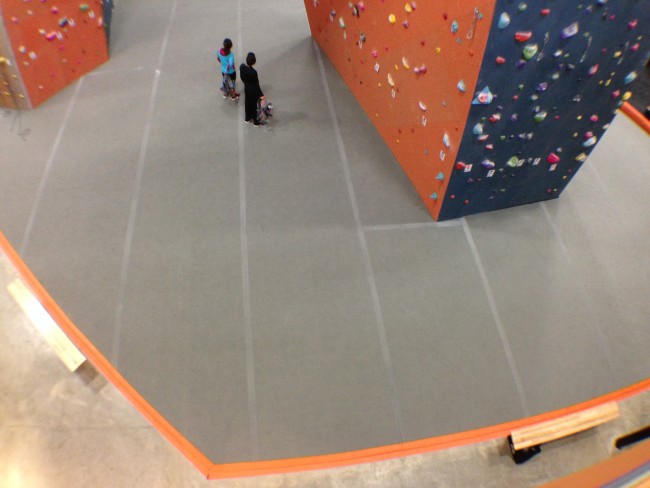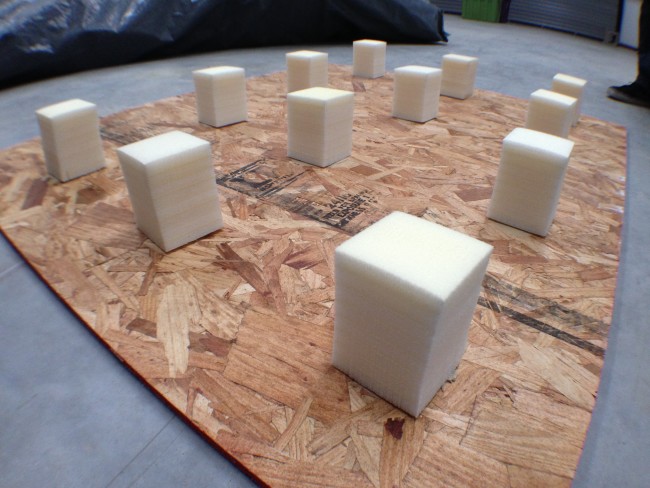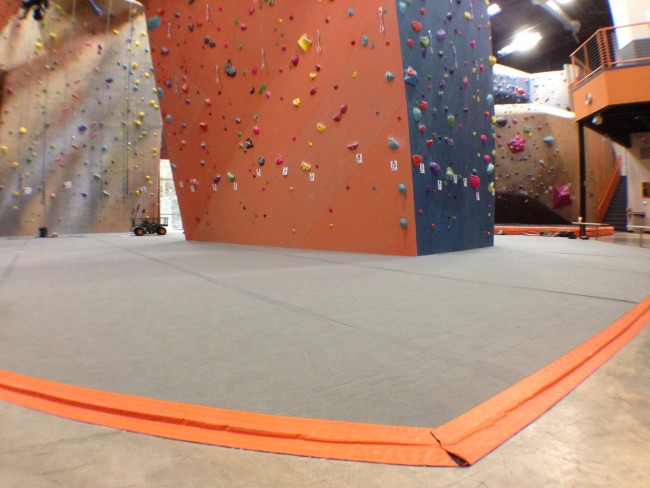
Cedric Colby, General Manager of inSPIRE Rock in Houston, Texas likes to do things a little different. That’s why during the design phase of the climbing facility he and owner Paul Short tried to look at every aspect of their plans to see if they were doing it the best way possible.
What they found was that many climbing facilities across the country had unprofessional, unsafe and unsightly flooring in their rope areas.
Squishy padding that was tiresome to stand and walk on, seams that buckled, edges that spread and soft spots at landing zones were just a few of the undesirable traits they found in traditional flooring systems.
So Colby started looking around at the other flooring options. He looked not only at current climbing gym flooring but at gymnastics and judo floor design. “I ate, drank and slept this stuff,” said Colby when CBJ visited inSPIRE in January.
After looking at all the available options Colby and Short decided to create their own flooring system. Taking a little bit from gymnastic, judo and climbing flooring systems they created a system that eliminates all the negatives they had seen in other gyms.
What is a Floor For?
The first step in designing a padding system for their roped areas was to determine the purpose of the padding in the first place. Was it there to protect a ground fall from the top of the wall? Since no flooring company or flooring system can guarantee a completely safe fall from 40, 50 or 60 feet, the inSpire team’s next step was to determine at what height most ground falls actually happen.
“The primary purpose for the top-rope and lead floor is to protect the 8 foot fall,” said Colby. This is a common traversing height and the height at which a climber might fall before clipping the 1st or 2nd quick-draw. With proper belaying, a ground fall is less likely to happen after the 3rd quick-draw.
The inSpire system
Most climbing gym flooring is one or two inches of carpet-bonded closed-cell foam on top of several inches of open-cell foam. This is actually how most outdoor crash pads are constructed and this design has been adopted by climbing gyms. But as Colby told us, “One of the problems with putting Dollamur [closed-cell foam] on top of open-cell foam is that it’s not designed to be on top of it — it’s designed to be on a firm surface. One of the problems that you get when it’s on foam is that the Dollamur spreads really quickly.”
Gym managers with this problem regularly have to trim the spreading foam. And of course when foam spreads it also thins and causes those unsafe and unsightly buckled seams.

So Colby put the carpet-bonded closed-cell foam directly on top of solid OSB sheeting and then placed 4” EVA foam blocks every foot or so under that OSB. “Basically I’m using [Dollamur] as the manufacturer intended it to be used. It’s also more cost effective than using open cell foam under your two inch Dollamur,” said Colby.
According to Colby the goal of the OSB and foam blocks is to absorb the impact of a fall by splitting and breaking during an impact.
“Behind my concept is just a theory that it would potentially protect a forty foot fall. Potentially. By having the air underneath and by breaking the OSB and dissipating the force,” said Colby.
To make the system function and look as professional as possible inSpire built a 5 ½” recessed “bathtub” around the top-rope and lead climbing structure which allows the padding system to be nearly flush with the rest of the floor in the non-climbing area. This means no awkward step up or fall-inducing step down.

When one walks on the inSPIRE flooring for the first time it’s hard to keep yourself from bouncing. The floor has the same springy qualities as a gymnastic floor which allows gymnasts to jump high in the air and the cushioning effects that allow them to land safely.
Though the floor has this “bouncy” quality to it, it is still extremely stiff and stable. This stability, combined with the nearly uniform height of the floors, meant that inSpire passed their ADA inspection the first time around and may be one of the few climbing gyms in America that has wheelchair access to all of the rope climbing areas.
Risk and Liability
While developing the inSPIRE floor Colby wanted to make sure that he followed certification guidelines. But what he found was that there are no guidelines, no certification, no requirements.
Insurance companies and even the CWA have no guidelines about flooring systems. “It’s nerve racking. There’s no guidelines! They just say you have to have an impact-attenuated floor, and this is an impact-attenuated floor,” Colby said.
So does he worry about the increased liability of an untested floor? “I personally don’t think that there is an increased liability. These floors have been used in high-impact situations for years and years,” said Colby. However, he cautions “There is no guarantee with any floor.”
No matter how much work a management team puts into the safety features of a gym, Colby thinks it’s still up to the climber to make it home safely.
“We have to do our due diligence about informing the climbers about the risks of climbing,” said Colby. “It comes down to the fact that the climbers and belayers are responsible for their own safety. The gym is just providing you with an opportunity to climb. We’re Reimers Ranch. We’re the Red River Gorge. We’re providing you with a place to climb and you’re responsible for your life. So, if you happen to deck, god, we hope you’re OK.”

Climbing Business Journal is an independent news outlet dedicated to covering the indoor climbing industry. Here you will find the latest coverage of climbing industry news, gym developments, industry best practices, risk management, climbing competitions, youth coaching and routesetting. Have an article idea? CBJ loves to hear from readers like you!






